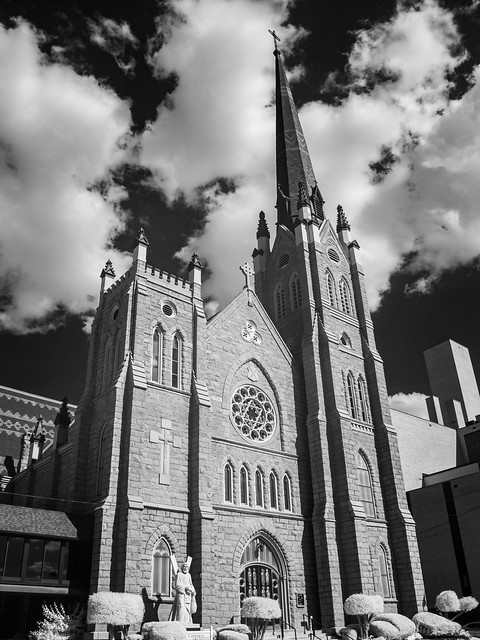
Tuesday, August 31, 2021
St. Andrew
I had to run some errands downtown, so I brought the infrared camera with me. I made a quick stop outside of the Cathedral of St. Andrew, which was built way back in 1881. The steeple is 220 feet tall, and was the tallest structure in Little Rock until 1916, when the dome of the Arkansas State Capitol took over the title. It is still the ninth tallest structure in the city, surprisingly taller than the 300 Third Tower and the Marriott Little Rock (the old Excelsior/Peabody).


Labels:
Arkansas,
Infrared,
Infrared Black and White,
Little Rock
Location:
Little Rock, AR, USA
Sunday, August 29, 2021
St. Louis
Despite all the pictures in the last post here, we did see more of St. Louis besides the Arch. But I didn't bring a camera into most of the other places we visited (like Busch Stadium or the Zoo). One afternoon we drove away from downtown and visited Crown Candy Kitchen, a cute little restaurant we saw featured on a TV show. The food was good (Jonah was excited about the ice cream and candy), although none of us were brave enough to order the sandwich with 14 pieces of bacon on it.
On the way up there, we passed by a good number of interesting old buildings. Of course I didn't have a camera with me - they were resting back at the hotel. Now I do realize it takes a certain level of person to fall in love with and to be married to a photographer. Someone with infinite levels of patience and grace, who will let an absent-minded person drift off into thoughts of driving around looking for photogenic old buildings. Luckily I married one of those saintly people. And after lunch, Caroline said she would look after Jonah for a bit if I wanted to go and take a few pictures. So I took her up on the offer and hurried to get a few pictures while they visited the City Museum.
So with cameras in hand, I backtracked by some of the neat old buildings that we drove by earlier.
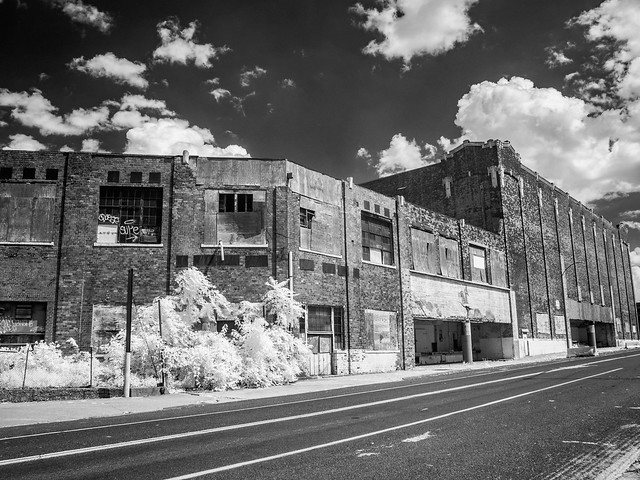

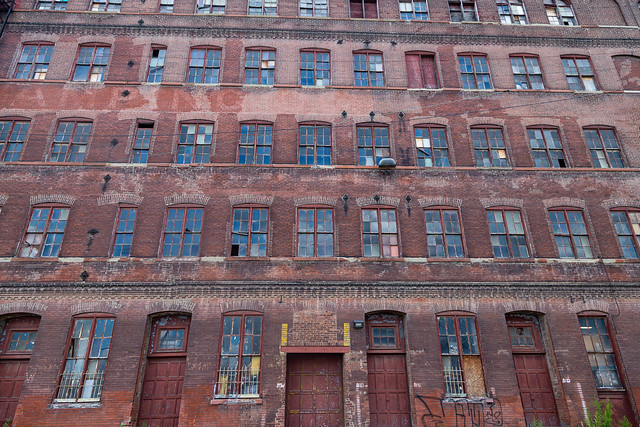


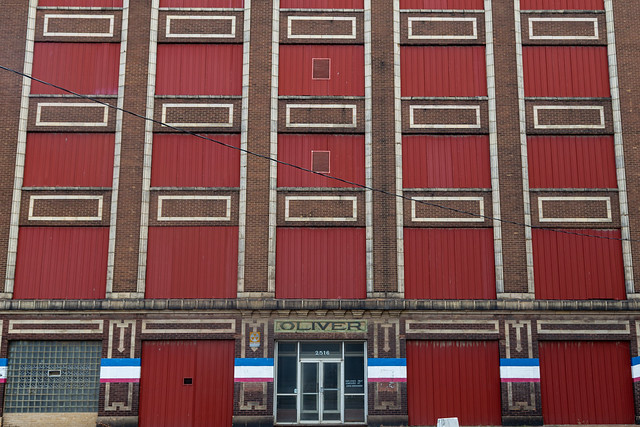

Of course I wasn't the only one out there with a camera....

This graffiti was on a nearby building, which just made me think of the poor sister in Parasite.

St. Louis has a deep history. The area that is now St. Louis was the home of the Native American Mississippian culture, who built massive mounds on both sides of the Mississippi River. The city of St. Louis was founded in 1763, and it would soon grow in prominence as the U.S. began moving into the western frontier. In 1904, St. Louis hosted both the World's Fair and the Olympics, and was the first city outside of Europe to host the games. The population of St. Louis peaked in 1950 at 856,000. But it has been steadily decreasing since then, with a current population sitting around 300,000 people.
The reasons for that population loss are many, and have been written about by people much more knowledgable about it than I am. But the evidence of that population loss is evident by the number of abandoned homes, many of which were built prior to World War II.



These neighborhoods are not empty, and I felt incredibly self-concious driving around taking pictures. I was some guy from out-of-state, running around taking pictures of the buildings that had been left behind in this area of the city. I didn't want to seem exploitative, since I do love finding and taking pictures of old buildings. But I really don't think anyone saw me or really cared that I was there, but I hated that someone might have thought I was there with bad intentions.

And another shot of the same building, but this one was with the infrared camera:
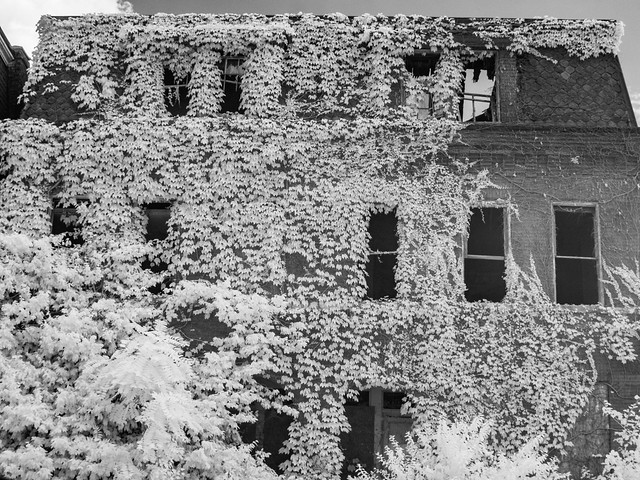
Nearby was this old Catholic church, which was built in 1889. Although the church has been listed on the National Register of Historic Places, it closed in the 1990s. The building has since been turned into a private skateboard park, with ramps and slopes installed where the congregation and altar once stood.

I stopped at a few other places nearby, like this old industrial-looking building:
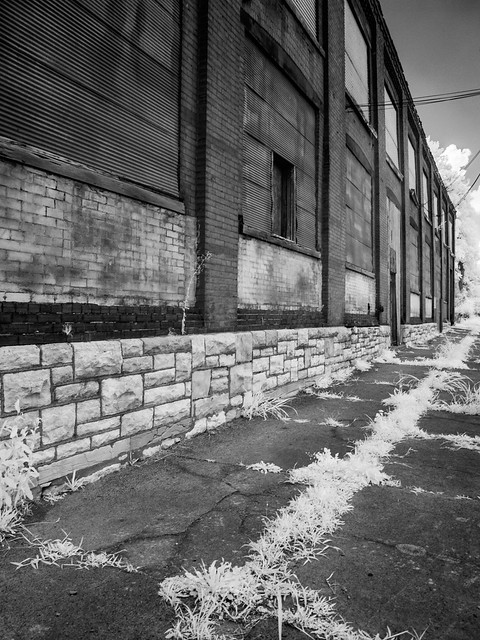
And also this partially-burned old brick home.

Further down the road was this old block of homes. It would be amazing to know the history of this building, and the people who once lived here.
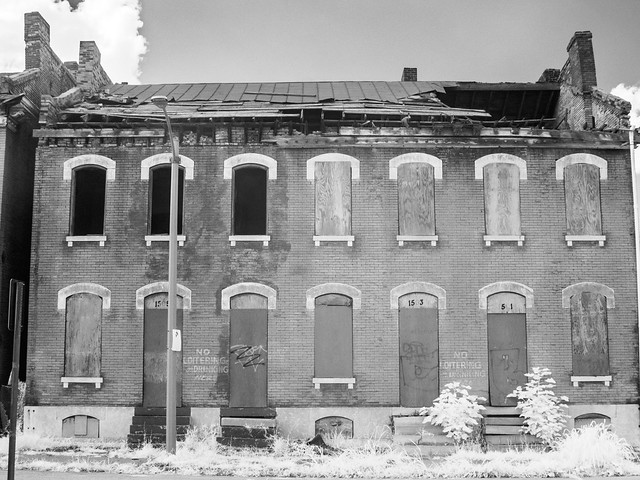

Nearby was another set of old homes, these completely covered with vines.

From there I headed back towards downtown and stopped at Union Station. The iconic station was built in 1904, and it became one of the largest and busiest train stations in the world.

Across the street from the station is the fountain called "The Meeting of the Waters." The fountain is meant to celebrate the meetings of the Mississippi and the Missouri Rivers. The male figure represents the Mississippi River, while the female figure represents the Missouri. They are joined by 17 water spirits, which are symbolic of the 17 smaller streams that empty into the two rivers. The fountain sits in Aloe Plaza, and was installed in 1939. Since the two main statues are nude, I'm guessing it's named Aloe Plaza since that's what the naked statues would need to use after getting sunburned from having so much exposed skin.

There are a bunch of family-friendly attractions around Union Station, and we returned later that day with Jonah to go up in the Ferris wheel. The wheel stands 200 feet tall and provides some great views of Union Station and downtown St. Louis.

On the way up there, we passed by a good number of interesting old buildings. Of course I didn't have a camera with me - they were resting back at the hotel. Now I do realize it takes a certain level of person to fall in love with and to be married to a photographer. Someone with infinite levels of patience and grace, who will let an absent-minded person drift off into thoughts of driving around looking for photogenic old buildings. Luckily I married one of those saintly people. And after lunch, Caroline said she would look after Jonah for a bit if I wanted to go and take a few pictures. So I took her up on the offer and hurried to get a few pictures while they visited the City Museum.
So with cameras in hand, I backtracked by some of the neat old buildings that we drove by earlier.







Of course I wasn't the only one out there with a camera....

This graffiti was on a nearby building, which just made me think of the poor sister in Parasite.

St. Louis has a deep history. The area that is now St. Louis was the home of the Native American Mississippian culture, who built massive mounds on both sides of the Mississippi River. The city of St. Louis was founded in 1763, and it would soon grow in prominence as the U.S. began moving into the western frontier. In 1904, St. Louis hosted both the World's Fair and the Olympics, and was the first city outside of Europe to host the games. The population of St. Louis peaked in 1950 at 856,000. But it has been steadily decreasing since then, with a current population sitting around 300,000 people.
The reasons for that population loss are many, and have been written about by people much more knowledgable about it than I am. But the evidence of that population loss is evident by the number of abandoned homes, many of which were built prior to World War II.



These neighborhoods are not empty, and I felt incredibly self-concious driving around taking pictures. I was some guy from out-of-state, running around taking pictures of the buildings that had been left behind in this area of the city. I didn't want to seem exploitative, since I do love finding and taking pictures of old buildings. But I really don't think anyone saw me or really cared that I was there, but I hated that someone might have thought I was there with bad intentions.

And another shot of the same building, but this one was with the infrared camera:

Nearby was this old Catholic church, which was built in 1889. Although the church has been listed on the National Register of Historic Places, it closed in the 1990s. The building has since been turned into a private skateboard park, with ramps and slopes installed where the congregation and altar once stood.

I stopped at a few other places nearby, like this old industrial-looking building:

And also this partially-burned old brick home.

Further down the road was this old block of homes. It would be amazing to know the history of this building, and the people who once lived here.


Nearby was another set of old homes, these completely covered with vines.

From there I headed back towards downtown and stopped at Union Station. The iconic station was built in 1904, and it became one of the largest and busiest train stations in the world.

Across the street from the station is the fountain called "The Meeting of the Waters." The fountain is meant to celebrate the meetings of the Mississippi and the Missouri Rivers. The male figure represents the Mississippi River, while the female figure represents the Missouri. They are joined by 17 water spirits, which are symbolic of the 17 smaller streams that empty into the two rivers. The fountain sits in Aloe Plaza, and was installed in 1939. Since the two main statues are nude, I'm guessing it's named Aloe Plaza since that's what the naked statues would need to use after getting sunburned from having so much exposed skin.

There are a bunch of family-friendly attractions around Union Station, and we returned later that day with Jonah to go up in the Ferris wheel. The wheel stands 200 feet tall and provides some great views of Union Station and downtown St. Louis.

Labels:
Infrared,
Infrared Black and White,
Missouri,
St. Louis
Location:
St. Louis, MO, USA
Sunday, August 22, 2021
Gateway Arch National Park
As a special treat before Jonah started kindergarten, we decided to take him on a little trip up to St. Louis for a few days. We hit a lot of the kid-friendly places there, like the St. Louis Zoo, the City Museum and a Cardinals game at Busch Stadium. Thanks to the Delta variant, it wasn't the best time to travel, but we wore masks and did our best to social distance from people whenever we could. We booked a hotel downtown, which provided this view of the place that Jonah said was his favorite place on our trip - the Gateway Arch.

We also had this view, looking down at the busy intersection of Broadway and Washington.

And I did bring the infrared camera with me, so I got this shot from the hotel window too.
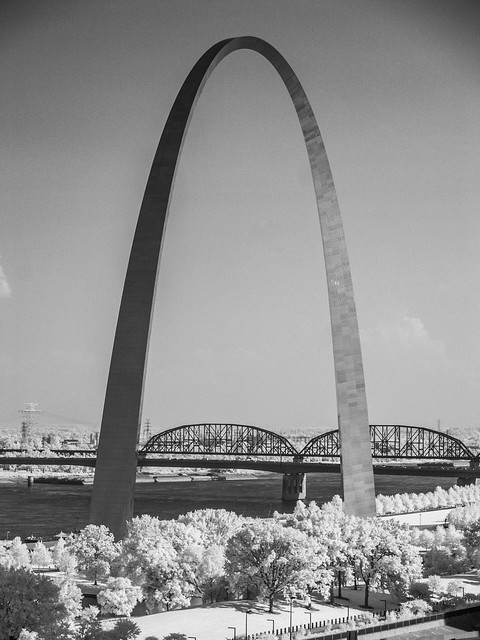
And I also brought the infrared camera with me when we walked to the Arch (my apologies to anyone who is tired of seeing infrared pictures!).

It had been about 15 years since I had last been up into the Arch. A lot has changed since then - the grounds of the Arch have been competely redone and improved. A cap has been placed over the freeway that divides the Arch from the rest of downtown, and a brand new visitor's center has been built.
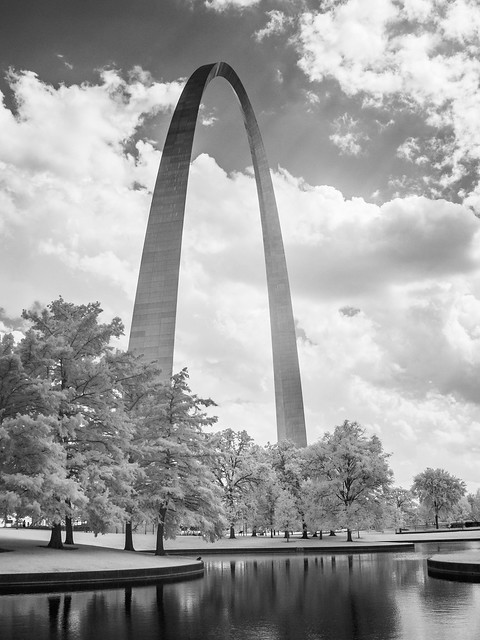
The other big change is that the Arch is now a National Park, which happened in 2018. By doing so, the Gateway Arch took the designation of the country's smallest National Park away from Hot Springs. Gateway Arch is only 192 acres, compared to Hot Springs' 5,549 acres. They are both miniscule compared to the country's largest National Park - Wrangell St. Elias National Park in Alaska with its 8.3 million acres.
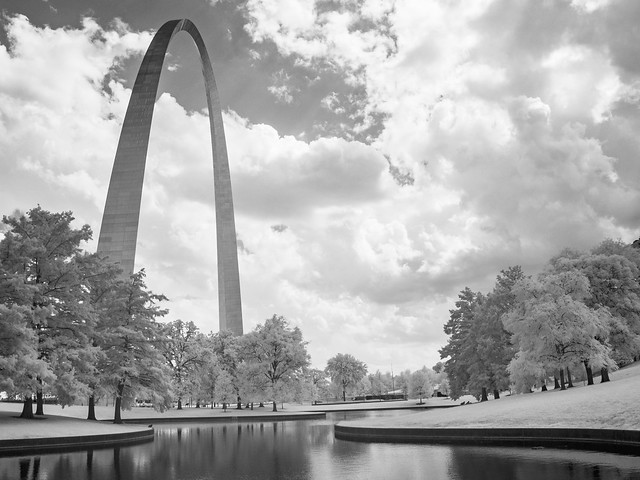
We went through the visitor's center and then walked through the museum underneath the Arch (which has all been redone). Thanks to Covid, only a limited number of people were allowed to go up to the top, and could only be up there for 15 minutes. Before going in we were nervous that Jonah would get freaked out while riding the tiny and cramped elevators that go up to the top, but he thought it was like a ride and was excited about it. After a few minutes we were at the top and we hurried to one of the windows to see the view...

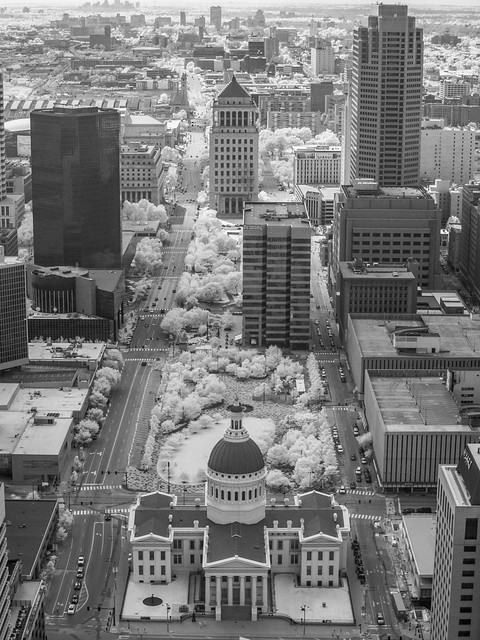


I only brought the infrared camera with me, but I did get this shot using the wide angle on the Iphone.
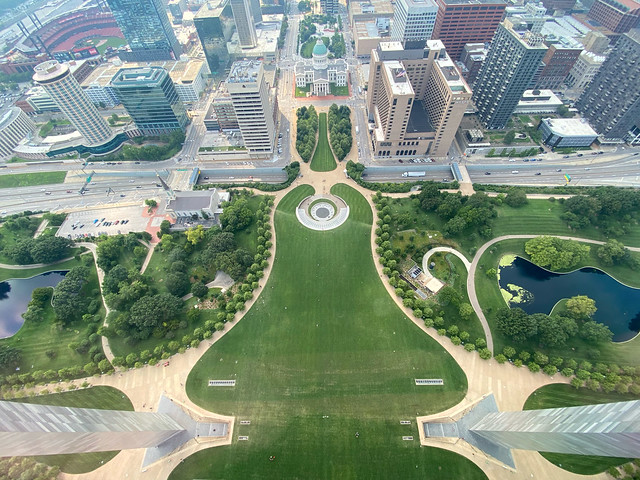
And then our time was up and we had to make our way back to the elevators and then onto the solid ground. On the walk back to the hotel I got one last shot with the infrared:
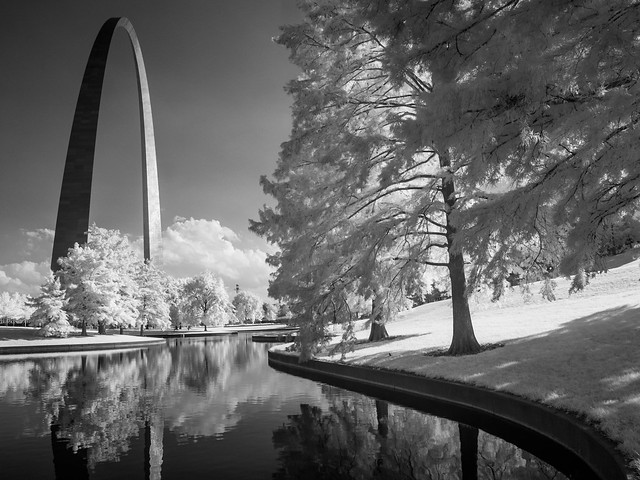
After putting Jonah to bed, I headed out and got a few more pictures of the Arch at dusk.


And the Arch towering over the Old Cathedral, which is formally known as the Basilica of Saint Louis, King of France. The cathedral was built in 1834 and was the first cathedral built west of the Mississippi River. The writing on the front translates as "In honor of St. Louis. Dedicated to the one and triune God. A.D. 1834."
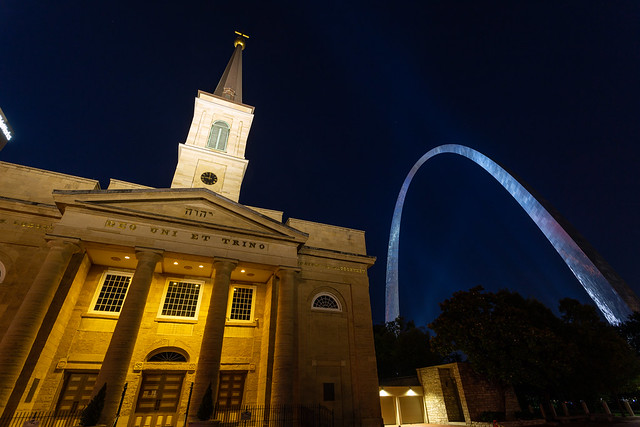
From there, I headed over to the Old Courthouse and Kiener Plaza. A prominent part of the plaza is the statue of the "Olympic Runner," and which was installed in honor of Harry J. Kiener (a local who was part of the the U.S. track team at the 1904 Olympics, which was held here in St. Louis).

The plaza has a great view of the Old Courthouse, which was completed in 1864. In 1846, the courthouse was the setting for the infamous Dred Scott case. And up until 1894, it was the tallest structure in the city.
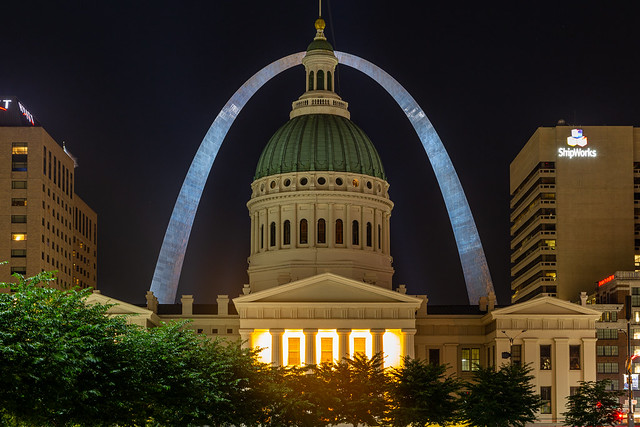
And another Iphone shot of the Old Courthouse and the Arch, from a rooftop bar where we got a quick drink one evening:
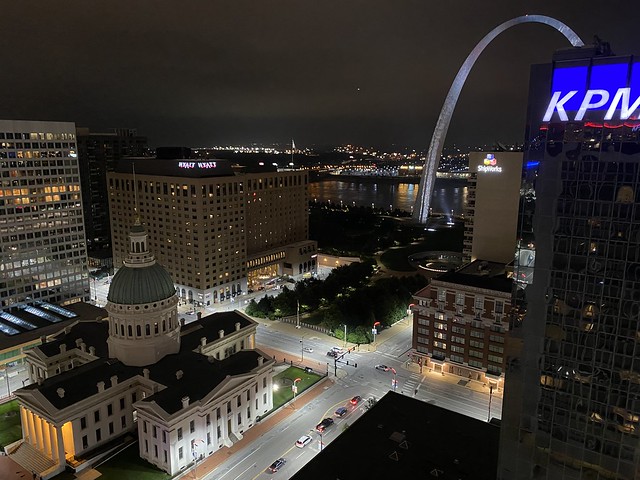
And one last shot, taken while we were getting ready to check out of the hotel. The light from the rising sun was casting a golden hue on the Arch...


We also had this view, looking down at the busy intersection of Broadway and Washington.

And I did bring the infrared camera with me, so I got this shot from the hotel window too.

And I also brought the infrared camera with me when we walked to the Arch (my apologies to anyone who is tired of seeing infrared pictures!).

It had been about 15 years since I had last been up into the Arch. A lot has changed since then - the grounds of the Arch have been competely redone and improved. A cap has been placed over the freeway that divides the Arch from the rest of downtown, and a brand new visitor's center has been built.

The other big change is that the Arch is now a National Park, which happened in 2018. By doing so, the Gateway Arch took the designation of the country's smallest National Park away from Hot Springs. Gateway Arch is only 192 acres, compared to Hot Springs' 5,549 acres. They are both miniscule compared to the country's largest National Park - Wrangell St. Elias National Park in Alaska with its 8.3 million acres.

We went through the visitor's center and then walked through the museum underneath the Arch (which has all been redone). Thanks to Covid, only a limited number of people were allowed to go up to the top, and could only be up there for 15 minutes. Before going in we were nervous that Jonah would get freaked out while riding the tiny and cramped elevators that go up to the top, but he thought it was like a ride and was excited about it. After a few minutes we were at the top and we hurried to one of the windows to see the view...




I only brought the infrared camera with me, but I did get this shot using the wide angle on the Iphone.

And then our time was up and we had to make our way back to the elevators and then onto the solid ground. On the walk back to the hotel I got one last shot with the infrared:

After putting Jonah to bed, I headed out and got a few more pictures of the Arch at dusk.


And the Arch towering over the Old Cathedral, which is formally known as the Basilica of Saint Louis, King of France. The cathedral was built in 1834 and was the first cathedral built west of the Mississippi River. The writing on the front translates as "In honor of St. Louis. Dedicated to the one and triune God. A.D. 1834."

From there, I headed over to the Old Courthouse and Kiener Plaza. A prominent part of the plaza is the statue of the "Olympic Runner," and which was installed in honor of Harry J. Kiener (a local who was part of the the U.S. track team at the 1904 Olympics, which was held here in St. Louis).

The plaza has a great view of the Old Courthouse, which was completed in 1864. In 1846, the courthouse was the setting for the infamous Dred Scott case. And up until 1894, it was the tallest structure in the city.

And another Iphone shot of the Old Courthouse and the Arch, from a rooftop bar where we got a quick drink one evening:

And one last shot, taken while we were getting ready to check out of the hotel. The light from the rising sun was casting a golden hue on the Arch...

Labels:
Gateway Arch,
Gateway Arch National Park,
Infrared,
Infrared Black and White,
Missouri,
St. Louis
Location:
St. Louis, MO, USA
Thursday, August 19, 2021
Infrared Hot Springs
One place I've wanted to take the new infrared camera is to Hot Springs. Way back in the olden days, I took a bunch of pictures of Hot Springs on infrared black and white film. It would be interesting (to me at least), to see how the pictures taken now compared with ones taken way back in the year 2000 (which you can see here).
So one day my wife and I headed down to Hot Springs for a few hours. We parked the car and I headed off to take a few pictures while she had a leisurely stroll down Central Avenue perusing the shops (which was the better option, since all those places had air conditioning and it was already nearly 95 degrees outside). Here is a view of the old Medical Arts Building, which was built in 1929 and has been almost entirely abandoned for the past few decades. Amazingly, someone has bought the building and plans to convert it into a hotel.

I walked over to a paved trail that runs up the hill by the display spring towards the Promenade. It was shady and slightly cooler here amongst the trees.
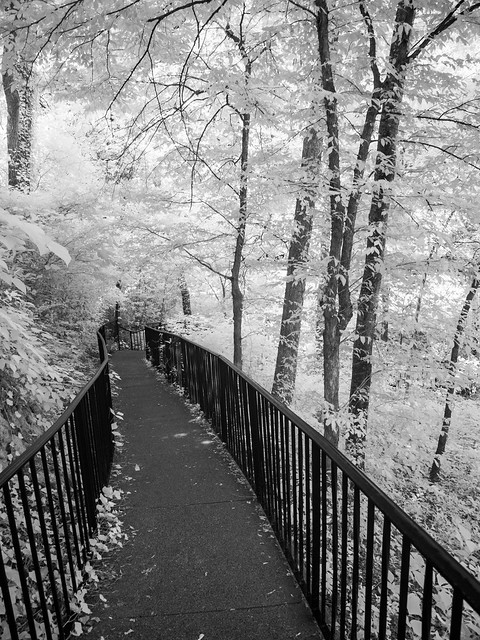
And then back to Bathhouse Row, which was fairly crowded with people along the sidewalks. I waited for gaps in people to get a few pictures of the bathhouses, framed by the magnolia trees along the road. Here is the Quapaw Bathhouse, built in 1922:
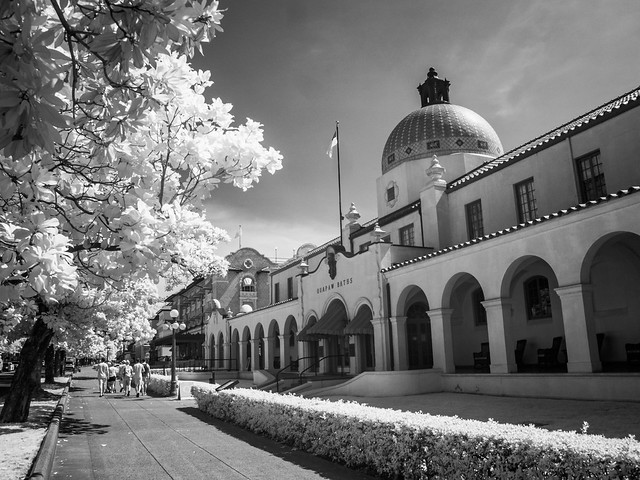
And the Ozark Bathhouse, which was also built in 1922:
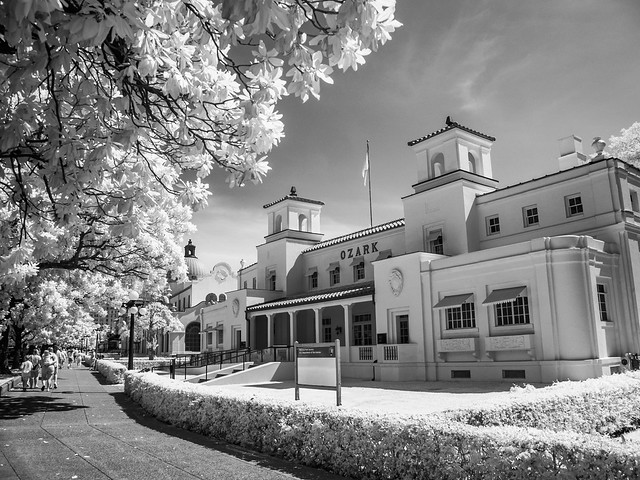
And the view of the Quapaw Bathhouse dome, from the Promenade:

And then one last shot from this visit, of the old Tom Moore cigar ghost sign. The sign is on the side of a building that was built in 1891.

So one day my wife and I headed down to Hot Springs for a few hours. We parked the car and I headed off to take a few pictures while she had a leisurely stroll down Central Avenue perusing the shops (which was the better option, since all those places had air conditioning and it was already nearly 95 degrees outside). Here is a view of the old Medical Arts Building, which was built in 1929 and has been almost entirely abandoned for the past few decades. Amazingly, someone has bought the building and plans to convert it into a hotel.

I walked over to a paved trail that runs up the hill by the display spring towards the Promenade. It was shady and slightly cooler here amongst the trees.

And then back to Bathhouse Row, which was fairly crowded with people along the sidewalks. I waited for gaps in people to get a few pictures of the bathhouses, framed by the magnolia trees along the road. Here is the Quapaw Bathhouse, built in 1922:

And the Ozark Bathhouse, which was also built in 1922:

And the view of the Quapaw Bathhouse dome, from the Promenade:

And then one last shot from this visit, of the old Tom Moore cigar ghost sign. The sign is on the side of a building that was built in 1891.

Location:
Hot Springs, AR, USA
Sunday, August 15, 2021
Mount Holly Cemetery
Mount Holly Cemetery is a great place to go and take pictures, especially if you want to get moody black and white photos. So it seemed like a perfect place to take the new infrared camera. I didn't have the best timing for being out, since this was in the afternoon on a hot and muggy summer day in Arkansas. I was quickly drenched in sweat, but the things we do for a few pictures...
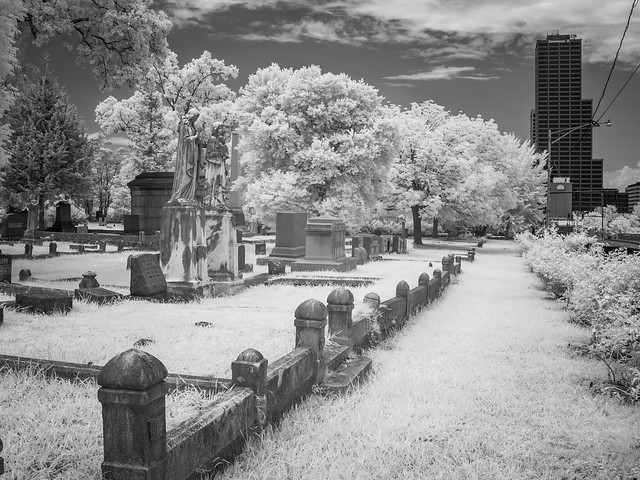
The cemetery was established way back in 1843, just twelve years after the city was founded. Mount Holly is the final resting place for many notable early residents of Little Rock and Arkansas. Among those buried here are eleven governors of Arkansas, thirteen state supreme court justices, four US senators, 21 mayors of Little Rock, and a Pulitzer Prize winning poet. Buried here are also a few other people who have been written about recently on this blog - including architect George R. Mann (who designed the Arkansas State Capitol and Little Rock Central High, among many other buildings), preservationist Louise Loughborough (who helped save several of Little Rock's oldest buildings, and led to the start of the Historic Arkansas Museum), and Adolphine Fletcher Terry (who was active in civil rights and who helped reopen Little Rock schools after they were shuttered by Orval Faubus).

A modest marker sits at the grave of Qatie Ross, the wife of the Cherokee chief John Ross. Qatie and John were travelling to Oklahoma during the Trail of Tears in 1839 when she caught pnemonia and passed away in Little Rock. She was buried at a cemetery that sits at the current location of the Federal Courthouse, but her grave was later moved here to Mount Holly. As you can see in this picture, people leave stones and coins on her gravestone.

The cemetery features a good number of Victorian-era stone markers and statues. Among them are these statues of the Virgin Mary and Joseph holding Christ, which stand out along the front row of the cemetery. The statues are at the grave of Justin Matthews, the real estate developer who designed several neighborhoods in North Little Rock, and who was the person who built The Old Mill.
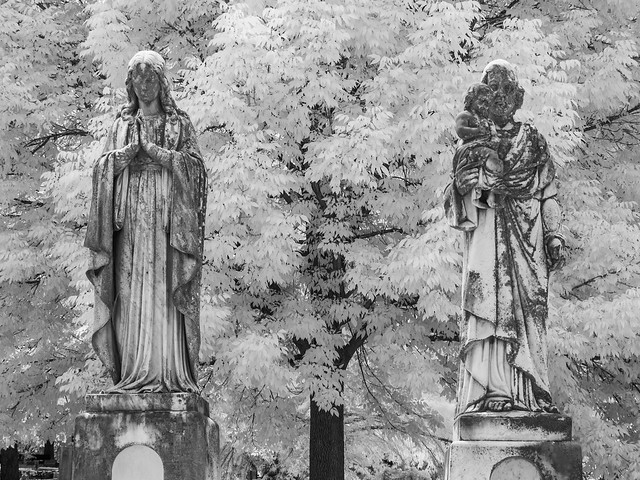
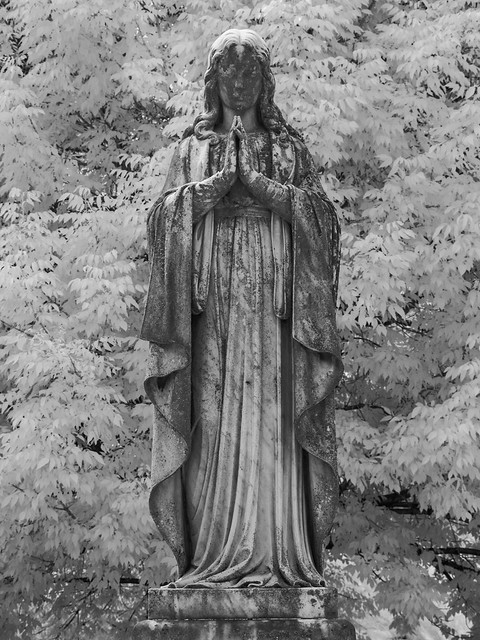
A tall monument that is surrounded by massive crepe myrtle trees belongs to George Watkins, who served as the chief justice of the Arkansas Supreme Court and was a prominent attorney in the 1800s.
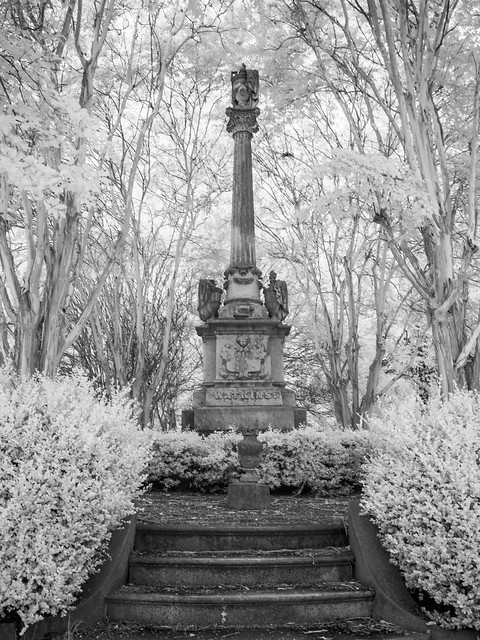
Although there have been some recent burials here (most notably Jennings Osborne), there are currently no available lots for sale. There are spaces available in the columbrian.

I headed back to the car and the welcome embrace of the air conditioning and then started heading home. But I did make one last stop while I was downtown, and got this shot of the new Broadway Bridge (which I guess isn't that new anymore, since it's been open since 2017).


The cemetery was established way back in 1843, just twelve years after the city was founded. Mount Holly is the final resting place for many notable early residents of Little Rock and Arkansas. Among those buried here are eleven governors of Arkansas, thirteen state supreme court justices, four US senators, 21 mayors of Little Rock, and a Pulitzer Prize winning poet. Buried here are also a few other people who have been written about recently on this blog - including architect George R. Mann (who designed the Arkansas State Capitol and Little Rock Central High, among many other buildings), preservationist Louise Loughborough (who helped save several of Little Rock's oldest buildings, and led to the start of the Historic Arkansas Museum), and Adolphine Fletcher Terry (who was active in civil rights and who helped reopen Little Rock schools after they were shuttered by Orval Faubus).

A modest marker sits at the grave of Qatie Ross, the wife of the Cherokee chief John Ross. Qatie and John were travelling to Oklahoma during the Trail of Tears in 1839 when she caught pnemonia and passed away in Little Rock. She was buried at a cemetery that sits at the current location of the Federal Courthouse, but her grave was later moved here to Mount Holly. As you can see in this picture, people leave stones and coins on her gravestone.

The cemetery features a good number of Victorian-era stone markers and statues. Among them are these statues of the Virgin Mary and Joseph holding Christ, which stand out along the front row of the cemetery. The statues are at the grave of Justin Matthews, the real estate developer who designed several neighborhoods in North Little Rock, and who was the person who built The Old Mill.


A tall monument that is surrounded by massive crepe myrtle trees belongs to George Watkins, who served as the chief justice of the Arkansas Supreme Court and was a prominent attorney in the 1800s.

Although there have been some recent burials here (most notably Jennings Osborne), there are currently no available lots for sale. There are spaces available in the columbrian.

I headed back to the car and the welcome embrace of the air conditioning and then started heading home. But I did make one last stop while I was downtown, and got this shot of the new Broadway Bridge (which I guess isn't that new anymore, since it's been open since 2017).

Labels:
Arkansas,
Little Rock,
Mount Holly Cemetery
Location:
Little Rock, AR, USA
Subscribe to:
Posts (Atom)

